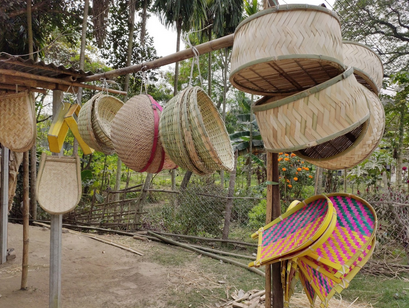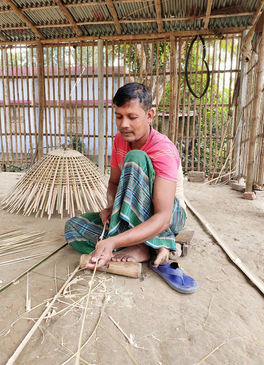Keeping Bamboo Crafts Alive
On the way to Mujibnagar, which was the first capital city of Bangladesh during the Liberation War*, one cannot help but notice a display of beautiful bamboo* products hanging in the place where the roads meet at the village of Bamonpara. The colourful products invite the attention of people who pass along the road, especially those people who love crafts* made by hand.

A small Hindu community of around sixty families, most of whom are from the Das cast*, is keeping this centuries old profession alive. Fifty-five-year-old Kamal Das is one of the members of the community who has been involved in this profession from an early age, when he learnt how to make bamboo products from his father. During the Liberation War, because it was not safe to stay, Kamol’s family, along with many other families living here now, had to run away from the country. They stayed in the Polashipara Refugee Camp* in Nodia, a village in West Bengal, India, and returned after the war.
The products Kamol Das and others make are bamboo baskets which range in size from small to large. They also make polo, kula, fishing traps, murgir khacha, and khoi caluni. Their products are made with great energy and love. There are several steps to making the products. Firstly, they pick the bamboo, and then they cut it into long thin pieces using a sharp boti. The next step is to make the surface of each piece smooth. This takes hours of rubbing with the knife. After that, they start sewing the pieces of bamboo by hand. It seems that they sew the pieces of bamboo together using needles which many villagers in Bangladesh use to make Nakshi Khantha*.
When the products are finished, it appears as if the thin pieces of bamboo are lying on or falling on one another, just like waves in the ocean. The villagers dry the products for a number of days and then they paint them either red or green, but mostly they paint them red because this colour makes the products attractive to the locals. Sometimes, they use both colours together, which means you will find the colours of the flag of Bangladesh used in the products. They also use other colours to make the products eye-catching to the customers who come from further away.

Not only the men, but also the women of Das families work at making the products, and they are just as skilled as the men at their craft. When it comes to making the colourful designs, it is the women who are the ones who are one step ahead. They put their own creativity into action, and show great artistic skill when they add the naskha, or designs.
The basket makers display their products in their open, tin shops beside the road. They hang the products using either jute* or plastic* ropes from a length of bamboo, which makes a display of colourful patterns in a row that catches the eye of anyone who is passing. Since the shops are beside the highway, many people stop as they travel on their way to different places, and buy the items to use when working around their house. Besides this, they themselves, or sometimes some local buyers take their products to the local bazaar* and sell them there as well. The small items, such as small-sized baskets and kula, cost around 50-100tk and the medium-sized items cost around 150-250tk; however, the big baskets cost much more, they are usually sold for around 1000tk.
Nowadays, even though plastic products are very popular among the villagers, these do not fully satisfy the customers. In fact, the people who buy the bamboo products find they are much more useful, and easier and more comfortable to use at home than the plastic ones. Because they are made by hand from natural materials, the bamboo baskets are more eco-friendly* than plastic products, which take many years to break down in the environment. Thus, the families who make these beautiful, artistic crafts by hand for their living, are not only keeping the craft alive in today’s modern world, they are also helping to protect our environment.
Glossary (It is not necessary to learn these words as they are not so common in English, and some words are Bangladeshi words)
- bamboo (noun) - a tall, thin woody plant that grows very quickly, in sections.
- bazaar (noun) - a market where people buy, sell and trade goods.
- cast (noun) - a social group, separate from others because of profession, rank or wealth. In this story the basket makers belong to the Das Cast.
- crafts (noun - plural) - items made by hand, often very beautiful.
- eco-friendly (adjective) - something that does not harm the earth and its environment.
- jute (noun)- a natural fibre often used to make rope or sacking. In Bangladesh it is called PÄá¹a.
- khoi caluni - kind of bamboo basket.
- kula - a kind of pan made of bamboo
- Liberation War (Noun phrase)- also called the Bangladesh War of Independence, 1971.
- murgir khacha - chicken coop made of bamboo
- naskha - designs.
- nakshi khantha - needlework/embroidery.
- plastic (noun) - a common material that is easy to shape, and is made by humans from many materials, including coal and oil.
- polo - a kind of fishing trap made of bamboo
- refugee camp (noun phrase) - a temporary place to stay for people who have had to leave their home because of war or natural disaster.
_____________________________________________________________________
Learning Activities
Vocabulary
-
Words from the second 1000 high frequency General Service List.
ahead attractive comfortable especially knife pattern ropes satisfy shops thin alive basket customers flag needle pick row sew skill tin attention century/centuries during invite ocean profession rubbing sharp smooth
Words from the Academic Word List
| community | energy | liberation |
| creativity | environment | medium |
| design | involved | range |
| display | item |
Comprehension Questions
1. Remembering: Where exactly can you buy the baskets made by Kamal Das and his family?
2. Remembering: Why do the families of the Das cast make bamboo products? (Think of more than one reason.)
3. Understanding: Why do you think the baskets are sold at the place “where the roads meet” near Bamonpara?
4. Understanding: Why is it important for the craft work to be colourful?
5. Understanding: What does it mean to be “one step ahead” of someone?
Critical Thinking Questions
-
Analysing: Work with a partner. Using the information in the story, describe the good and bad points of bamboo and the good and bad points of plastic products?
-
Analysing: Work with a partner or in a small group. In English, explain the advantages of selling products on the roadside compared with selling them in a bazaar.
-
Applying: Think of an example, in English, of a time when you were “one step ahead” of someone, or someone was “one step ahead of you.” Write this as a short story and share it with your classmates.
-
Applying: Do some research on an interesting traditional craft. In English, describe how it is made. If you had the time and opportunity, which traditional handcraft would you like to learn? Why? How could you go about learning it? (Your choice of traditional craft could come from Bangladesh or from another country if you prefer.) When you have finished, share your information in small groups and ask and answer questions about it. If you are able, bring some traditional items to class, and have a ‘display and discussion’ day.
-
Evaluating: Discuss in small groups. How important is it to make sure that traditional Bangladeshi crafts stay alive? Give reasons for your answer. Who should be responsible for making sure that these traditional crafts do not die out? Report your group’s ideas to the whole class.
-
Evaluating: The writer tells us that bamboo products are better for the environment than plastic products. Do you agree? (Why/why not?) Have a class debate in English about this. What can be done to encourage more people to buy natural products rather than plastic ones?
-
Creating: Work with a partner or in a small group. Take a 10-minute walk in the area in and around your school and photograph all the different kinds of plastic waste you can see. How many items did you find? What kinds of things were they? Bring your photos to class. Create a plan that will help get rid of the plastic waste. Use your photos, and some written information to present your plan in English to your classmates. (Explain how you will put your plan into practice, so as to make your school and the area around it cleaner and more free of plastic waste. Also explain how you will encourage people to recycle, reduce, repurpose (by creating something new) or reuse plastic items?) Find a way to put your plan into action.